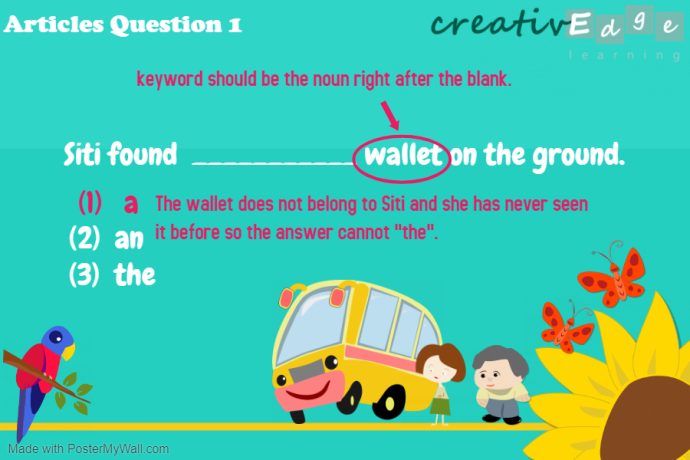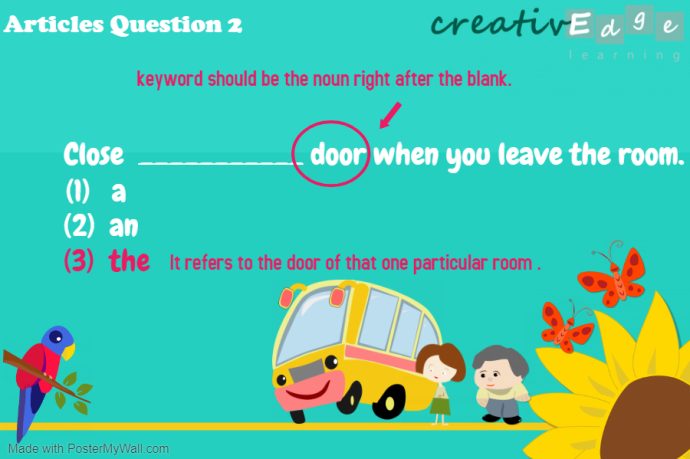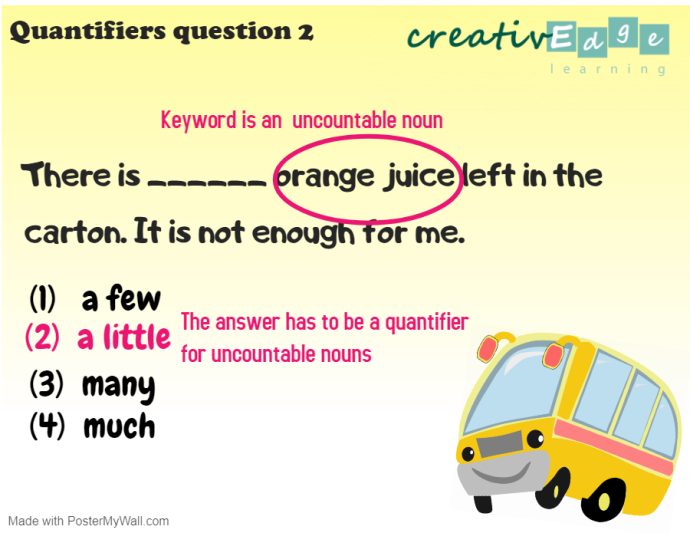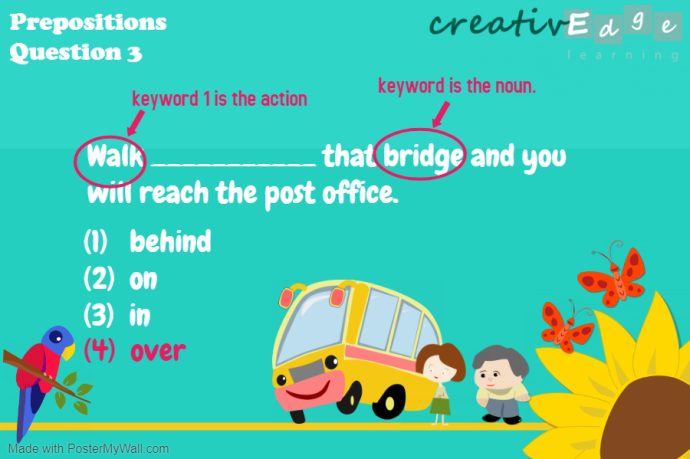
In the Primary 1 English syllabus, the learning of grammar is particularly important for Primary 1 pupils to build a strong foundation in the language.
With a strong understanding of the grammar rules, pupils will be able to write with grammatical accuracy. This then leads to pupils being able to complete the different sections of the English examination with ease and confidence.
In this post, we will cover the grammatical components that Primary 1 pupils should learn well as part of the Primary 1 English syllabus :
Articles
Articles are used right before a noun which can be a person, animal or thing.
Grammar rules for articles
- For nouns which are not known before, the articles a or an are used before the noun.
- For nouns which are known before, the article the is before the noun.

Explanation of answer for Question 1
The keyword is wallet. It did not belong to Siti and she had not seen it before. Therefore the article can be a or an.
However, the noun wallet does not start with a vowel (a , e, i, o, u) so the answer should be a.

Explanation of answer for Question 2
The keyword the room shows that it is the one particular door of the room and not just any room so the answer must be the.

Explanation of answer for Question 3
The keyword is apple as Mother gave me an ordinary apple and there is no other keywords in the sentence to indicate that it was one particular apple.
The noun apple starts with a vowel (a , e, i, o, u) so the answer should be an.
Quantifiers
A quantifier is a word or words used before a noun to indicate the quantity.
Grammar rules for quantifiers
- For countable nouns (people , animal and things which can be counted), the quantifiers such as many, few, a few are used before the noun.
- For uncountable nouns, quantifiers such as much, a little, little are before the noun.
- There are quantifiers which can be used for both countable and uncountable nouns. An example is some.
Grammar rules for articles

Explanation of answer for Quantifiers Question 1
The keyword is birds.
Since we can count the number of birds, it is a countable noun. Therefore the answer has to be many which is a quantifier for countable nouns.

Explanation of answer for Quantifiers Question 2
The keyword is orange juice.
A common mistake that Primary 1 pupils make is to assume that orange juice is usually in a glass or carton so it is a countable noun. This is only correct if the question states a glass of orange juice or a carton of orange juice.
Since this question only states orange juice, it is an uncountable noun. The quantifiers a little and much are possible answers. Keyword 2 it is not enough for me shows the low quantity so the answer must be a little.

Determiners
Determiners are used to point to people and things.
Grammar rules for determiners:
- Singular determiners such as this and that are used to point to a single person or thing.
- Plural determiners such as those and these are used to point to multiple persons or things

Explanation of answer for Determiners Question 1
The first keyword to identify is the noun. In this case, it is the flower. The possible answers are that and this.
Keyword 2 shows exactly where to point to, the keywords over there means to point in that direction so the answer has to be that huge smelly flower.

Explanation of answer for Determiners Question 2
The first keyword to identify is the noun. In this case, it is the watch. The possible answers are that and this.
Since there is no second keyword to show where the determiner is pointing at, pupils must assume that it is this watch.
Personal Pronouns
Personal pronouns are used to refer to people, things and animals which are already stated in a sentence.
Grammar rules for personal pronouns
- Personal subject pronouns like “he, “she”, “I” , “it” , “they” and “we” are always used right before an action verb.
- Personal object pronouns such as “me”, “him” , “us” , “them”, “it” and “her” are objects of a verb or preposition. This means that they can be used right after a verb or preposition.

Explanation of answer for Personal Pronouns Question 1
The first keyword is younger siblings as they are the people whom Hassan shares his toy with.
Since Hassan has more than one younger sibling, the personal pronoun has to be one that refers to groups of people. In this case, the only possible answer is them.

Explanation of answer for Personal Pronouns Question 2
The keyword is kitten so the personal pronoun has to be one which can refer to an animal .
The answer can only be it as it is the only personal pronoun which can be used to point to one animal or thing.
Primary auxillary verbs
A primary auxillary verb is used to form the tenses, moods and voices of other verbs.
Grammar rules for primary auxillary verbs :
- It is always used before other verbs or “action words”.
- The primary auxillary verbs are used based on the singular or plural noun as well as the past or present tense.
| Singular | Plural | Present Tense | Past Tense |
| I | am | was | |
| He, She, It | is | was | |
| You | are | were | |
| We , They | are | were |

Explanation of answer for Primary auxillary verbs Question 1
The first keyword dogs shows that the correct primary auxillary has to be one that can be used for plural nouns.
The second keyword now shows the time which refers to the present. Therefore are is the correct answer as it is an auxillary verb which is used for plural nouns in the present

Explanation of answer for Primary auxillary verbs Question 2
The first keyword I shows that the correct primary auxillary has to be one that can be used for singular nouns.
The second keyword yesterday shows the time which took place in the past.
In this case, the correct answer is was as it is an auxillary verb which is used for singular nouns and in the past tense.

Explanation of answer for Primary auxillary verbs Question 3
The words Sam and Ravi form the first keywords as they refer to two boys which is a plural noun.
The second keyword just now shows the time which took place in the past.
In this case, the correct answer is were as it is an auxillary verb which is used for plural nouns and in the past tense.
Contractions
A contraction is a shortened form of a word or a group of words. It is often used in speech.
Grammar rules for contractions :
| Contraction Type 1 | Contraction Type 2 | |
| I | I’m = I am | I’ll = I will |
| He | He’s = He is or He has | He’ll = He will |
| She | She’s = She is or She has | She’ll = She will |
| It | It’s = It is or It has | It’ll = It will |
| You | You’re = You are | You’ll = You will |
| They | They’re = They are | They’ll = They will |
| We | We’re = We are | We’ll = We will |

Explanation of answer for Contractions Question 1
The keywords are Those boys. The relevant personal pronoun to Those is they. Since there are two boys, the primary auxillary verb has to be are.
Therefore the answer must be They’re which is the contraction for They are.

Explanation of answer for Contractions Question 2
The keywords are my. The relevant personal pronoun to my is I. The two possible answers are I’m and I’ll.
To decide which option is the correct answer, use the words for each contraction and insert it in the question :
- I’m => I am waiting for my father….
- I’ll => I will waiting for my father…
It is clear that only option (1) is grammatically correct so the answer must be I’m.
Prepositions
A Preposition show the position of a person, place or thing.
For the Primary 1 English grammar syllabus, the learning starts with basic prepositions such as on, in, at, by, between, beside and under.
Grammar rules for prepositions :
- It is generally used between a verb and a noun.

Explanation of answer for Prepositions Question 1
Keyword 2 the shelf is insufficient for the answer as the preposition can be under the shelf as well as on the shelf.
The action in Keyword 1 determines the answer. One must put the book back on the shelf.

Explanation of answer for Prepositions Question 2
With keywords 1 and 2 , there is only one logical answer among the four options. The answer is sits beside her as the preposition beside has the same meaning as next to.

Explanation of answer for Prepositions Question 3
A common wrong answer that pupils write for this question is on as walk on sounds correct.
It is important to note that the keyword bridge shows a position higher than ground level. The correct preposition must reflect this higher position.
In this case, the answer must be over as this preposition refers to movement at a higher level.
Present tense
There are two types of action verbs in the present tense – singular and plural forms.
Grammar rules for present tense:
- Singular present tense is used when there is one person and ends with “s”, “es” or “ies”
- Plural present tense is used when there is more than one person, thing or animal

Explanation of answer for Present Tense Question 1
The keywords the twins show that there are two persons and the keywords every Sunday shows that the swimming lessons are ongoing and happening in the present.
Therefore the answer has to be in the plural present tense which is go.

Explanation of answer for Present Tense Question 2
The keyword Susan shows that there is only one person.
Note that there is no keyword indicating time so by default, the action is treated as happening in the present. As such, the answer has to be in the singular present tense which is lives.
Join us for our English enrichment class for Primary 1 which provides precise and thorough instruction for all components of the Primary 1 English syllabus.




this is the best way of approaching to learn the language for the learner and the tutor
I like it
Excellent work out there.